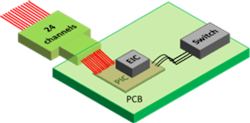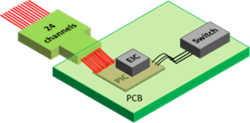Leti announces project to develop Si-photonics-based transceivers
Grenoble, France. Leti, an institute of CEA Tech, has announced the launch of a European Commission Horizon 2020 project to enable mass commercialization of Si-photonics-based transceivers to meet future data-transmission requirements in data centers and supercomputing systems.
The Leti-coordinated COSMICC project will combine CMOS electronics and Si-photonics with high-throughput fiber-attachment techniques. These scalable solutions will provide performance improvement an order of magnitude better than current VCSEL transceivers, and the COSMICC-developed technology will address future data-transmission needs with a target cost per bit that traditional wavelength-division multiplexing (WDM) transceivers cannot meet.
For example, the project’s 11 partners from five countries are focusing on developing mid-board optical transceivers with data rates up to 2.4 Tb/s with 200 Gb/s per fiber using 12 fibers. The devices will consume less than 2 pJ/bit and cost approximately 0.2 Euros/Gb/s.
“By enhancing an R&D photonic integration platform from project member STMicroelectronics, the partners in COSMICC aim to demonstrate the transceivers by 2019,” said project leader Ségolène Olivier of Leti. “We also plan to establish a new value chain that will facilitate rapid adoption of the technologies developed by our members.”
Several technological developments will be used to boost the photonic integration platform’s high data-rate performance, while also reducing power consumption.
A first improvement will be the introduction of a SiN layer that will allow development of temperature-insensitive MUX/DEMUX devices for coarse WDM operation. In addition, the SiN layer will serve as an intermediate wave-guiding layer for optical input/output to and from the photonic chip.
Additional steps will enhance modulator performance to 50 Gb/s, while making the transceivers more compact and reducing energy consumption. The partners will also evaluate capacitive modulators, slow-wave depletion modulators with 1D periodicity, and more advanced approaches. These include GeSi electro-absorption modulators with tunable Si composition and photonic crystal electro-refraction modulators to make micrometer-scale devices. In addition, a hybrid III-V on Si laser will be integrated in the SOI/SiN platform in the more advanced transmitter circuits.
Project demonstrators will be tested in both lab and field environments.
In addition to Leti, project participants include STMicroelectronics (France), STMicroelectronics (Italy), University Pavia (Italy), Finisar (Germany), Vario-Optics (Switzerland), Seagate (UK), University Paris-Sud (France), University St. Andrews (UK), University Southampton (UK) and Ayming (France).
About the Author

Rick Nelson
Contributing Editor
Rick is currently Contributing Technical Editor. He was Executive Editor for EE in 2011-2018. Previously he served on several publications, including EDN and Vision Systems Design, and has received awards for signed editorials from the American Society of Business Publication Editors. He began as a design engineer at General Electric and Litton Industries and earned a BSEE degree from Penn State.

